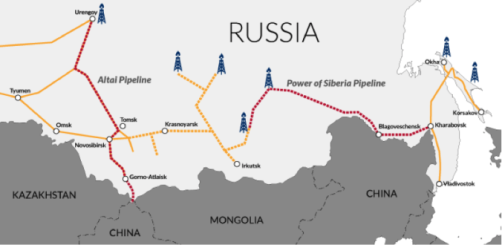The latest trade figures on Chinese/Russian trade should be further warning to the U.S. that economic sanctions do not work. In May 2017 Russian and China agreed to increase bilateral trade to $80 billion by the end of 2018.
Well, they’re a year ahead of schedule…
The official figures for 2017 came in at $84.07 billion.
They did more than $8.1 billion in business in December alone. With the opening of the new ESPO oil pipeline connecting Siberia to China doubling the amount of oil China can import to 600,000 barrels per day we’ll see those numbers continue to accelerate.
And that’s the key. Remember, the massive $400 billion gas deal China made with Gazprom in 2014 hasn’t begun delivering gas. The first Power of Siberia pipeline isn’t due to be completed until 2019. The second Power of Siberia pipeline is on the table after this one.
And the two countries just agreed to a third pipeline to bring gas in from Russia’s far east last month.
So, despite back-biting from western media about the profitability of these projects, they are going forward and the two countries continue to strengthen fundamental ties to one another.

Greasing the Skids
We are now just a week away from trading yuan-denominated oil futures on the Shanghai International Energy Exchange(INE). Trading begins January 18th.
And while that won’t change the face of oil futures overnight, it will begin shifting price discovery away from U.S. dollar markets. It will also improve external yuan liquidity as well as visibility for Russian oil on the global market.
The Shanghai contract is for Medium Sour crude which is closer to the type of oil mainly produced by Russia. Russian Urals crude is considered Medium Sour. Saudi Arabia’s and most of OPEC is sour oil (higher in sulfur with a lower pH). With the OPEC production cuts which Russia agreed to emulate, mostly hit this market.
Both WTI and Brent crude are benchmarks for Light Sweet Crude like that of the U.S. shale producers, Venezuela, Nigeria and Libya. So, this contract is designed to properly price other grades of oil not tailored to U.S. refinery needs.
And for that reason alone it will be a major competitor in the long run. The current oil market is heavily fragmented because there is no direct futures market for Sour grades of crude.
Shanghai’s contract is changing that game. Between this and that profits from it can be converted to gold via the Shanghai Gold Exchange, gives this market immediate credibility.
The effects of this have been over-stated on the one hand by hard-money advocates and under-stated on the other by entrenched financial analysts.
The important takeaway is that China has created the first unassailable and above-ground challenge to the petro-dollar oil trade. To break the world’s use of the dollar as the sole settlement currency for oil required the right contract issued by a country the U.S. can’t immediately invade and conduct a regime change operation in – like in Iraq and Libya.
Russia wins here because now there is a path for its Urals grade to become an international benchmark like WTI and Brent. And since Gazprom prefers to price its long-term gas contracts based on underlying oil prices rather than the more volatile natural gas price, this is also a win in the long run for them.
Gold convertibility is a means to deepen China’s sovereign debt markets by making it less risky to hold Chinese bonds. The lack of true yuan convertibility is the big impediment to people holding them. So, gold convertibility creates a viable exit route.
A Means to an End
Increasing trade between Russia and China has to and will go far beyond energy for its partnership to thrive. The oil trade is simply a means to building the underlying capital flow between the two countries. It makes it easier for Russian businesses to get access to Chinese capital and vice versa.
And this rapid acceleration of bilateral trade is necessary in the face of more severe U.S. economic sanctions against Russia likely coming next month. The way to avoid sanctions is to build alternate means to do business.
We will continue to target Russian banks and financial oligarchs with the idea of curtailing economic growth by cutting out their ability to source overseas capital. And again, this is why China is so important to Russia.
Because the more we push them away the more they can turn to their Chinese partners for assistance and the U.S. doesn’t dare sanction China, no matter how much President Trump bloviates about it.
China announced last week that it would not longer be accumulating U.S. treasury assets. Presumably, this mean that it will no longer recycle its trade surplus with the U.S. to halt appreciation of the Yuan versus the dollar. [ZH: of course this was denied within 24hrs but the threat remains]
It’s had to over the past year with the dollar weakening like it has. But that wave is coming to an end with a reversal of Fed policy and Trump’s tax cut bill. Rising rates in the U.S. will allow China to divest its Treasury holdings at its leisure without overly affecting the Yuan while it also deepens Yuan liquidity through its now gold-convertible bond market.
Those trade dollars will be spent in pursuit of China’s One Belt, One Road initiative and overseas where it has business. I’m sure if Russia gets into another dollar-funding crisis with new sanctions China will be there to provide dollar liquidity, just like in 2015.
Both countries understand the stakes and continue to make the right moves to support the changing macroeconomic environment. With U.S. bonds on the verge of entering a bear market conditions are ripe for China to deploy its massive savings to resume remaking the Asian continent.


